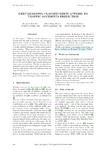Deep learning classification applied to traffic accidents prediction

Use este enlace para citar
http://hdl.handle.net/2183/31411
A non ser que se indique outra cousa, a licenza do ítem descríbese como Atribución-NoComercial-CompartirIgual 4.0 Internacional (CC BY-NC-SA 4.0)
https://creativecommons.org/licenses/by-nc-sa/4.0/deed.es
Coleccións
Metadatos
Mostrar o rexistro completo do ítemTítulo
Deep learning classification applied to traffic accidents predictionData
2022Cita bibliográfica
Coll-Josifov, R., Masip-Álvarez, A., Lavèrnia-Ferrer, D. (2022) Deep learning classification applied to traffic accidents prediction. XLIII Jornadas de Automática: libro de actas, pp.964-971 https://doi.org/10.17979/spudc.9788497498418.0964
Resumo
[Abstract] In this paper, YOLOv4 neural networks are trained with the goal of detecting and classifying objects from a street as seen from a drone. These have been trained on the VisDrone dataset, which is firstly validated through a custom-made graphic user interface. Then, several tests regarding performance, dataset composition and contrast have been carried out on the trained models. Results are compared to those from other previously existing models in order to evaluate their performance and analyse their shortcomings. The trained models are then used to detect and classify objects in a city scenario in real-time. Finally, an algorithm is proposed to track the objects, infer their future trajectories and predict potential collisions from the expected trajectories.
Palabras chave
You Only Look Once (YOLO)
Computer vision
Deep learning
Accident prediction
Computer vision
Deep learning
Accident prediction
Versión do editor
Dereitos
Atribución-NoComercial-CompartirIgual 4.0 Internacional (CC BY-NC-SA 4.0)
https://creativecommons.org/licenses/by-nc-sa/4.0/deed.es
ISBN
978-84-9749-841-8






